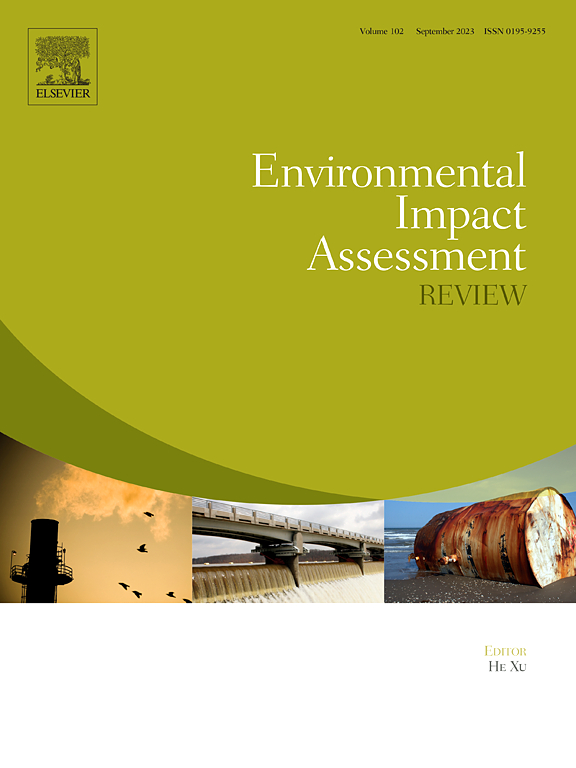Characterizing dam fragmentation impacts on freshwater fish within life cycle impact assessment
IF 9.8
1区 社会学
Q1 ENVIRONMENTAL STUDIES
引用次数: 0
Abstract
Damming-induced fragmentation hinders crucial fish migration for feeding and spawning and alters habitat quality. However, the Life Cycle Assessment (LCA) framework lacks a model to quantify the impacts of freshwater habitat fragmentation. Our proposed methodology addresses this gap by developing characterization factors (CFs) with global coverage for the isolation risk of 7369 freshwater fish species. We use a macroecological range size-body size relationship to determine species' Minimum Viable Range Size (MVRS) and apply it to assess range fragmentation caused by 31,870 dams. To consider multipurpose reservoirs, we allocate the quantified impact in Potentially Disappeared Fraction of species (PDF) based on a ranking approach. The CFs express global quantified impact and range from 0 to 2.39·10−12 PDF·yr·m−3 for hydropower for 524 basins, and from 0 to 3.17·10−07 PDF·yr·m−3 for irrigation for 1355 basins worldwide. We calculate a weighted mean from the CFs per basin to obtain a global CF. This CF is 3.89·10−15 PDF·yr·m−3 (± 2.01·10−14 weighted standard deviation) for hydropower and 7.66·10−14 PDF·yr·m−3 (± 2.27·10−12 weighted standard deviation) for irrigation. Applying the hydropower and irrigation CFs to a global case study for the operation of a hydropower plant and the production of basmati rice shows that the impact scores for fragmentation exceed those for land inundation and global warming but not for water consumption. In the case of Norway, the hydropower-induced fragmentation impact scores are the highest. This shows the importance of including freshwater fragmentation in decision-making tools such as LCA.

在生命周期影响评估中确定大坝破碎化对淡水鱼类的影响
筑坝引起的破碎化阻碍了至关重要的鱼类洄游觅食和产卵,并改变了栖息地的质量。然而,生命周期评估(LCA)框架缺乏量化淡水生境破碎化影响的模型。我们提出的方法通过开发具有全球覆盖范围的7369种淡水鱼的隔离风险表征因子(CFs)来解决这一差距。我们使用宏观生态范围大小-体型大小的关系来确定物种的最小生存范围大小(MVRS),并将其应用于评估31,870个水坝造成的范围破碎化。为了考虑多用途水库,我们基于排序方法分配了物种潜在消失分数(PDF)的量化影响。CFs表达了全球量化影响,524个流域的水电影响范围为0 ~ 2.39·10−12 PDF·yr·m−3,1355个流域的灌溉影响范围为0 ~ 3.17·10−07 PDF·yr·m−3。我们从每个流域的CF中计算加权平均值,以获得全球CF。水力发电的CF为3.89·10−15 PDF·yr·m−3(±2.01·10−14加权标准差),灌溉的CF为7.66·10−14 PDF·yr·m−3(±2.27·10−12加权标准差)。将水电和灌溉CFs应用于水电站运行和巴斯马蒂大米生产的全球案例研究表明,破碎化的影响得分超过土地淹没和全球变暖的影响得分,但不超过水消耗的影响得分。以挪威为例,水力引起的破碎影响得分最高。这显示了将淡水碎片化纳入LCA等决策工具的重要性。
本文章由计算机程序翻译,如有差异,请以英文原文为准。
求助全文
约1分钟内获得全文
求助全文
来源期刊

Environmental Impact Assessment Review
ENVIRONMENTAL STUDIES-
CiteScore
12.60
自引率
10.10%
发文量
200
审稿时长
33 days
期刊介绍:
Environmental Impact Assessment Review is an interdisciplinary journal that serves a global audience of practitioners, policymakers, and academics involved in assessing the environmental impact of policies, projects, processes, and products. The journal focuses on innovative theory and practice in environmental impact assessment (EIA). Papers are expected to present innovative ideas, be topical, and coherent. The journal emphasizes concepts, methods, techniques, approaches, and systems related to EIA theory and practice.
 求助内容:
求助内容: 应助结果提醒方式:
应助结果提醒方式:


